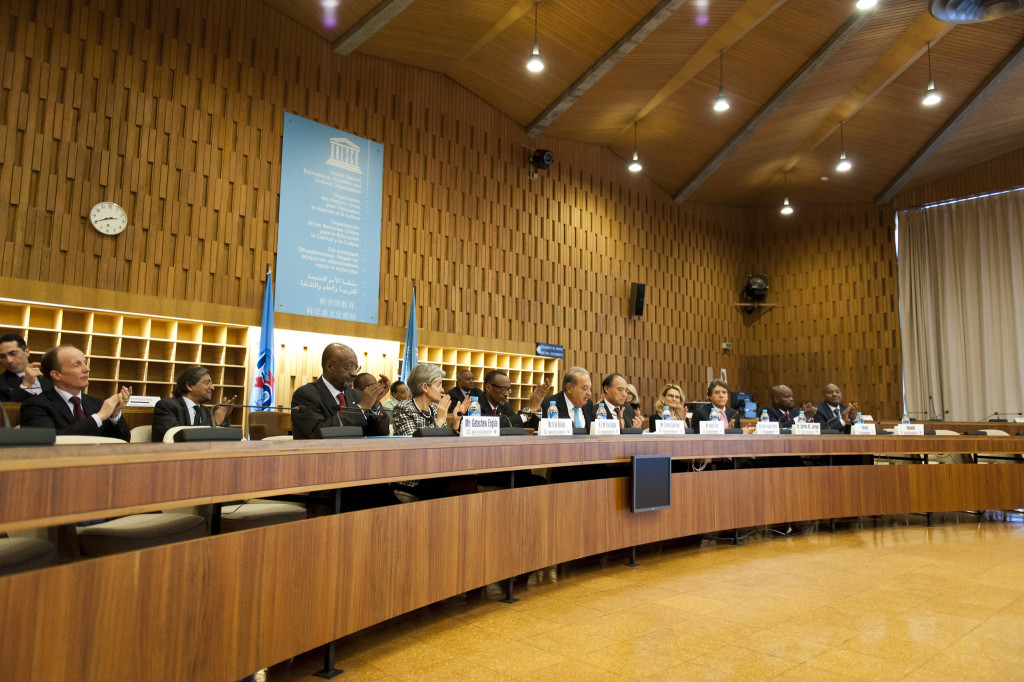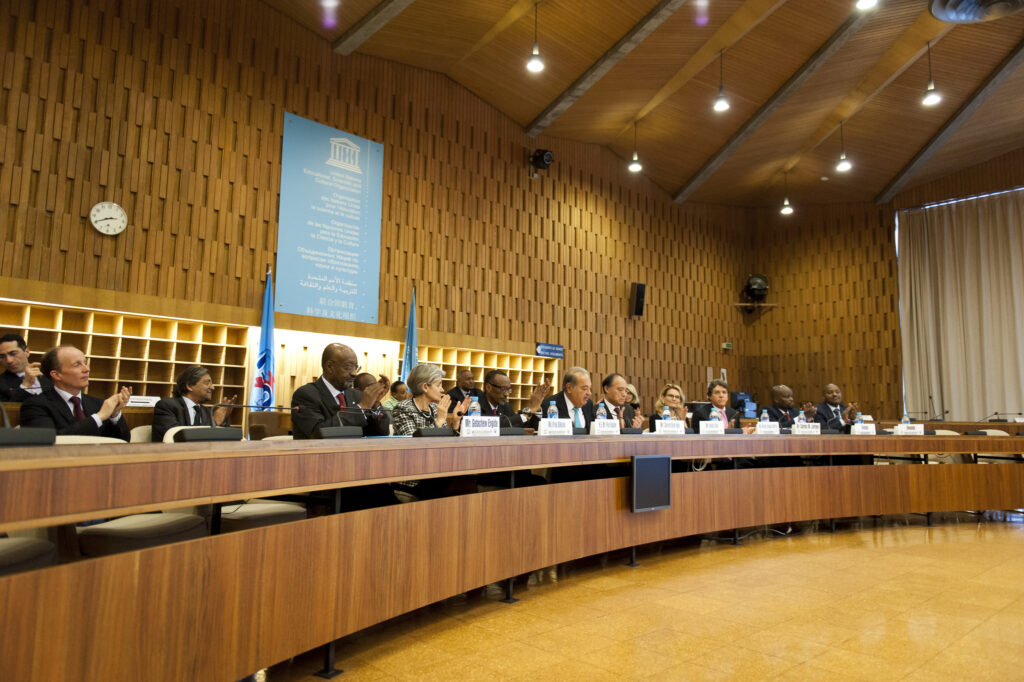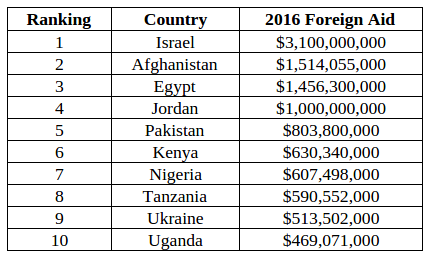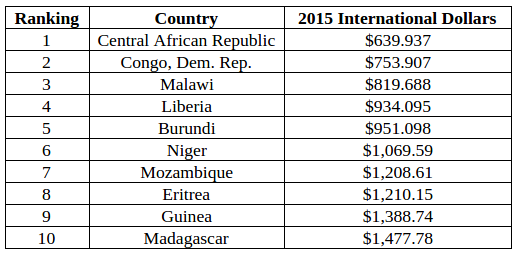
Within any government, the allocation of foreign aid gets encumbered by some of the worst bureaucracy and political inanity. Despite comprising just 1% of the federal budget, politicians have expressed a passionate commitment to ensuring that it gets dispersed in accordance with their political leanings and agendas. Historically, however, it has been a large facet of US foreign policy, securing many of the country’s interests outside of development. If we look at a list of countries receiving the most aid, we can quickly discern that there is not a perfect correlation between poverty or need and a country’s position:
Table 1. Top US Foreign Aid Recipients for the 2016 Fiscal Year
Table 2. Poorest Countries by Gross Domestic Product (GDP) Based on Purchasing-Power-Parity (PPP) per Capita
In Table 1, we can detect the underlying pattern: the US has strategic interests in all of the countries listed, especially concerning national security. The countries in Table 2 may have the greatest need, but don’t offer as much political ROI.
Given the current schism around foreign aid, politicians may find potential in a new initiative that would fall within the extant foreign policy goals and demand less direct involvement: increasing Internet penetration in developing countries. This could act as a political, economic and cultural catalyst for change and further the US’ national interest in strategically critical regions of the world.
Combatting disease, curing the sick and protecting the marginalized are of course essential—they concern life and death. However, in looking at the programs seeking to cultivate prosperous economies, foster conditions in which private exchange may occur and flourish, and combat corrupt governments and violence towards civilians, the Internet has thus far been an undervalued foreign policy tool.
Today, only one in three people have access to the Internet, what could now be considered a significant resource. The Internet is a global marketplace, an unparalleled educational platform and so much more. And though its reach is perpetually expanding, the increasing number of people with mobile and tablet devices means it isn’t moving fast enough.
Firstly, the untapped economic potential of the Internet is astounding. Considering that it is a fairly recent development for even the most industrialized economies, the long-term effects of it remain unknown. The World Bank lacks reference to any data prior to 2007. However, many studies suggest that Internet access leads to increased economic development. One study published in the American Economic Review found a direct correlation between an increase in Internet penetration and a country’s trade: for every 10% increase in connectivity, a country sees a 1.7 % increase in exports and 1.1% increase in imports. Those appear small, but they amount to millions, perhaps billions, of dollars in wealth. The return on investment could be far greater now considering the study was done back in 2002 and Internet penetration has grown exponentially.
With maturation, this access has immeasurable implications. Over the past 5 years, the Internet has accounted for 21% of the GDP growth among developed economies. Considering the baseline of these more established economies, developing countries could see far greater growth.
For these countries, this kind of growth stems from access to new information and collective knowledge about new market places and opportunities. Rural farmers receive agricultural data for the first time. People geographically isolated find access to critical resources, such as clinics, shelters and aid. Merchants expand their reach to a global network of consumers. Cyber-connectivity eradicates enormous barriers to economic development: scarcity, lack of infrastructure and marginalization become hindrances, not obstructions.
Colombia, in particular, has taken note of this emerging trend to alleviate poverty. Its government seeks to subsidize a fiber-optics network that spans 96% of its towns and cities, and provides all citizens with cloud storage space. Although ambitious, they’ve seen dramatic results. According to Diego Molano, Colombia’s minister for information and communications technology, this initiative has helped pull 2.5 million Colombians out of the trenches of poverty. At its genesis, the country had 2.2 million broadband connections; today, it sees numbers as high as 8.8 million, which amounts to 80% of its population.
Aside from the economic development evinced in Colombia’s program, expanding connectivity serves another strategic interest for foreign policy: millions of people become connected for social and political change. One of the greatest threats to corrupt, dictatorial and failed regimes is this kind of communication network. To use a perhaps belabored example: the Arab Spring was a movement that successfully supported a national effort to overthrow a dictatorship. Indeed, the subsequent system may be a tenuous, precarious version of democracy, but people were able to mobilize on a massive scale. Even if social media didn’t catalyze the revolution, it did unequivocally empower the Libyan people in a way that hadn’t been possible ten years before.
And without the extreme example of a national coup d’état, the Internet still allows greater political participation and inevitably increases transparency. Places previously dark to the outside world could share their experiences on the ground and communicate information in real time. How may this have altered the evolution of past genocides or government brutality?
Of course, history has proven that authoritarian regimes can manipulate the Internet too. The Internet opens up greater opportunities for government spying, disseminating violent propaganda and censorship. But given its limitless nature, this kind of control is becoming increasingly more difficult. We see this with China and Russia, where anti-government groups still manage to spread their collateral to millions of people. To say that no Internet is better than a limited form would be drastic consequentialist thinking.
Moreover, this kind of self-empowerment and sustainability is exactly what foreign aid aims at in its investments. Internet provides both the economic development and innovative tools for political and social reform that create stability. And, unlike so many of the programs USAID currently facilitates on the ground, Internet connectivity is a sustainable model for growth. Thus it defies the “teach a man to fish” conundrum so many often cite in opposition. Benefits for USAID’s other largest initiatives, such as health and humanitarian assistance, will come as externalities of increased Internet penetration. One of the major challenges for non-profits operating on the ground is reaching the local population; that fundamentally changes with widespread Internet connection.
With newly developed technology and a wealth of research, now is the time to make the Internet a priority for foreign aid. Countries no longer need to install cell towers for Internet access. Facebook and other large companies are working to proliferate the number of people with access to broadband with major initiatives such as Internet.org, a program that uses high-altitude, long-endurance planes, satellites and lasers to bring Wi-Fi to rural areas. They’re eager to engage governments to implement their ideas. Google, IBM and several other large tech companies are equally dedicated to expanding global Internet access.
While the private sector has taken the initiative on this particular endeavor, the partnership with governments expedite execution and provide financing and resources otherwise difficult to tap into. Therefore, the private sector becomes an incredibly productive resource for the government to use—their priorities are aligned. If the US becomes involved with these initiatives as part of their foreign aid programs, it would not only accelerate its foreign policy agenda, but may also lay a foundation that can have a long-lasting return on investment for its various agencies.
The views expressed by the author do not necessarily reflect those of the Glimpse from the Globe staff, editors or governors.









